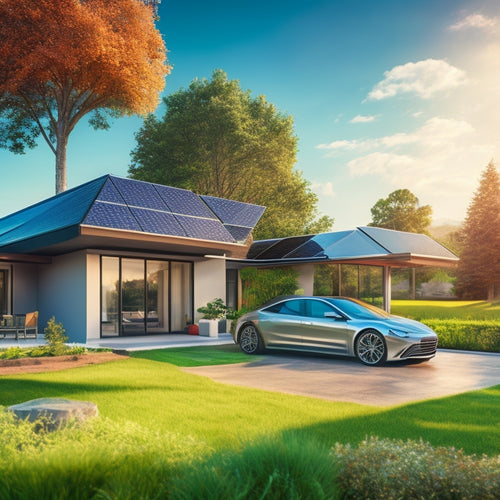
5 Things to Know About the Average Cost of Solar Panels
Share
When it comes to investing in solar panels, understanding the average cost is essential. You'll find that prices vary depending on the type of panel, with monocrystalline being the most expensive and thin-film being the most budget-friendly. Installation location, system size, and technology type also play a significant role in determining cost. On average, a residential solar installation costs between $15,000 and $30,000, including panels, inverters, and labor. While upfront costs may seem steep, incentives like federal tax credits and state rebates can help offset the expense. As you examine your options, you'll uncover more ways to make solar energy a financially savvy choice for your home.
Key Takeaways
- The average cost of a residential solar installation ranges from $15,000 to $30,000, depending on system size, panel type, and installation method.
- Higher-efficiency monocrystalline panels are typically more expensive than polycrystalline and thin-film panels, which offer lower efficiencies at lower prices.
- Installation costs vary based on location, with high labor costs and complex roof structures increasing expenses, and larger systems requiring more equipment and labor.
- Federal, state, and local incentives, such as tax credits and rebates, can significantly reduce the upfront cost of solar panels and enhance their affordability.
- While the initial investment is substantial, solar panels can provide long-term savings of up to $500 per year on electricity bills and increase property value.
Understanding Solar Panel Pricing
When you start investigating solar panel options, one of the first questions that comes to mind is, "How much do solar panels cost?" While it's a simple question, the answer can be complex, as solar panel pricing varies widely depending on several factors.
You'll find that different solar panel types, such as monocrystalline, polycrystalline, and thin-film, have distinct price points. Monocrystalline panels, for instance, are typically more expensive than polycrystalline ones. Thin-film panels, on the other hand, are often the most budget-friendly option.
Installation methods also impact the overall cost. Rooftop installations, which involve mounting panels directly onto your roof, are generally more expensive than ground-mounted systems. Additionally, the complexity of the installation process, including factors like roof size and electrical infrastructure, can drive up costs.
As you explore further into the world of solar panels, it's important to understand these variables to make an informed decision about your investment.
Factors Affecting Cost Variation
Your solar panel investment is susceptible to various influences that can drive costs up or down. As you traverse the complex environment of solar panel pricing, it's crucial to understand the factors that contribute to cost variation.
Several key factors can impact the cost of your solar panel system:
-
Panel efficiency: Higher-efficiency panels may cost more, but they can also generate more power per unit area.
-
Installation location: Installing solar panels in areas with high labor costs or complex roof structures can increase overall costs.
-
System size: Larger systems require more equipment and labor, driving up costs.
- Technology type: Different types of solar panels, such as monocrystalline or thin-film, can vary greatly in price.
Additionally, market demand and financing options can also influence the cost of your solar panel system.
Understanding these factors will help you make an informed decision about your investment and guarantee you get the best value for your money.
Average Cost of Solar Installation
Clarity emerges as you investigate the average cost of solar installation, a vital aspect of your renewable energy investment. This cost encompasses the entire installation process, from planning to commissioning. On average, the total cost of solar installation ranges from $15,000 to $30,000 for a typical residential system. This amount includes the cost of solar panels, inverters, mounting hardware, and labor.
When calculating the average cost of solar installation, it's important to take into account the installation process. This process typically involves site assessment, system design, permitting, installation, and testing. The complexity of your roof, local building codes, and labor costs in your area can influence the overall cost.
Financing options can greatly affect the average cost of solar installation. You can choose to pay cash upfront, secure a loan, or lease the system. Each financing option has its pros and cons, and understanding these options is important for making an informed decision.
Savings From Solar Incentives
As you've considered the average cost of solar installation, you're likely wondering how to reduce that expense. One way to do so is by taking advantage of various solar incentives. These incentives can greatly lower the upfront cost of solar panels, making them more accessible to homeowners like you.
Some of the most notable incentives include:
-
Federal Tax Credit: You can claim a tax credit of up to 26% of the total cost of your solar panel system.
-
State Rebates: Many states offer rebates or cash incentives for installing solar panels, which can range from a few hundred to several thousand dollars.
-
Local Programs: Your local government or utility company may offer special programs, such as installation grants or low-interest financing options, to encourage the adoption of solar energy.
- Energy Savings: Solar panels can help you save money on your energy bills, which can add up to considerable long-term savings.
Long-Term Value of Solar Panels
Most solar panel systems remain functional for at least 25 years, and many last even longer. This extended lifespan is vital in understanding the long-term value of solar panels.
As you consider investing in solar energy, you'll want to know that your system will continue to generate power and provide a return on investment (ROI) for decades to come.
Your solar panel system will save you money on electricity bills, and over time, those savings will add up. In fact, the average homeowner can save up to $500 per year on their electricity bills.
Additionally, solar panels increase your property value, making your home more attractive to potential buyers if you decide to sell.
Frequently Asked Questions
Can I Install Solar Panels on a Rented Property?
You're stuck between a rock and a hard place, wanting to utilize the sun's energy but being tied to a rented property. You'll need to review your rental agreements to investigate installation options, such as portable solar panels or negotiating with your landlord.
Are Solar Panels Affected by Weather Conditions Like Hail?
You're right to wonder if solar panels can withstand harsh weather; they're designed to be weather-resilient, but hail damage is possible. Look for panels with high impact resistance ratings to minimize damage from hail and other extreme weather conditions.
Can I Sell Excess Energy Back to the Grid?
You're utilizing the sun's power like a pro! Now, you're wondering if you can sell excess energy back to the grid. Yes, you can, through net metering benefits and energy buyback programs, allowing you to offset your utility bills and even earn credits.
Do Solar Panels Require Regular Maintenance?
You'll need to perform routine maintenance to guarantee peak energy output, but don't worry, it's relatively infrequent; most solar panels only require inspections every 6-12 months, and their lifespan can exceed 30 years with proper care.
Are Solar Panels Compatible With All Roof Types?
As you traverse the solar environment, you'll find that solar panels can harmonize with most roof types, but beware of incompatible roof materials, and consider installation angle constraints to guarantee maximum energy harvesting.
Related Posts
-

What Solar Panels Work Best With EVS Online?
When shopping for solar panels online to power your electric vehicle, look for high-efficiency models that can withst...
-

Why Choose Solar Car Battery Charging Systems?
You're switching to a cleaner, more sustainable transportation option by choosing solar car battery charging systems,...
-

What Role Do Unicycles Play in Urban Transport?
As you navigate through congested city streets, unicycles emerge as a viable solution, slashing carbon emissions by u...


